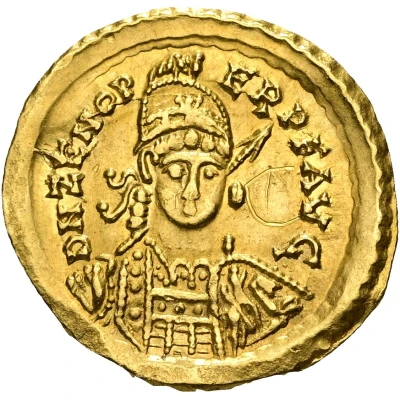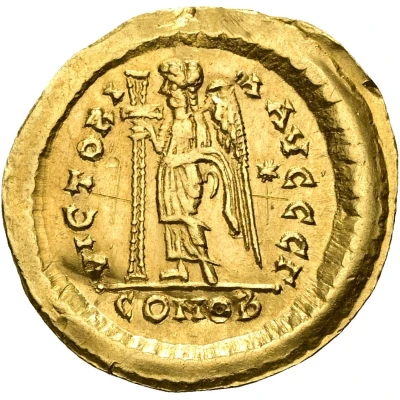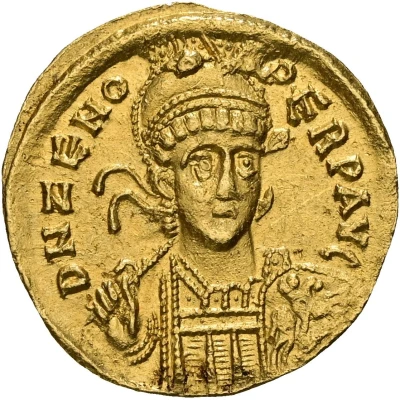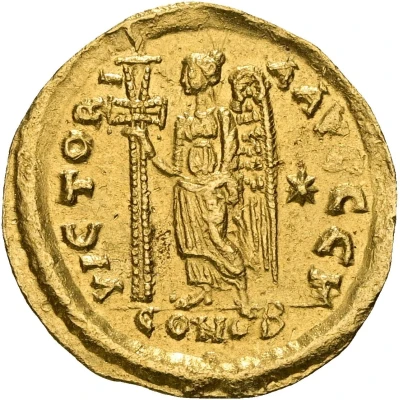


Solidus - Zeno VICTORIA AVGGGΓ; Rome
| Gold | 4.25 g | 20 mm |
| Issuer | Eastern Roman Empire (Rome) |
|---|---|
| Emperor | Zeno (474-491) |
| Type | Standard circulation coin |
| Years | 476-491 |
| Value | Solidus (1) |
| Currency | Solidus (330-476) |
| Composition | Gold |
| Weight | 4.25 g |
| Diameter | 20 mm |
| Shape | Round (irregular) |
| Technique | Hammered |
| Orientation | Variable alignment ↺ |
| Demonetized | Yes |
| Updated | 2024-10-10 |
| Numista | N#422654 |
|---|---|
| Rarity index | 97% |
Reverse
Victory, winged, draped, standing right, supporting long jeweled cross; star in right fieldr.
Officina mark ending the lettering and mintmark in exergue.
Script: Latin
Lettering:
VICTORI-A AVGGGΓ
COMOB
Unabridged legend: Victoria Augustorum
Translation: Victory of the Augusts
Comment
Issue from the first barbarian King Odovacer (Odoacer) in the pseudo imperial name of Zeno.
Odoacer, (born c. 433 AD — died March 15, 493 AD, Ravenna), first barbarian king of Italy. The date on which he assumed power, 476 AD, is traditionally considered the end of the Western Roman Empire. Odoacer was a German warrior, the son of Idico (Edeco) and probably a member of the Sciri tribe. About 470 AD he entered Italy with the Sciri; he joined the Roman army and rose to a position of command. After the overthrow of the Western emperor Julius Nepos by the Roman general Orestes (475 AD), Odoacer led his tribesmen in a revolt against Orestes, who had reneged on his promise to give the tribal leaders land in Italy. On Aug. 23, 476 AD, Odoacer was proclaimed king by his troops, and five days later Orestes was captured and executed in Placentia (now Piacenza), Italy. Odoacer then deposed and exiled Orestes’ young son, the emperor Romulus Augustulus. Odoacer’s aim was to keep the administration of Italy in his own hands while recognizing the overlordship of the Eastern emperor, Zeno. Zeno granted him the rank of patrician, but Odoacer styled himself “King.” He refused to acknowledge Julius Nepos, Zeno’s candidate, as Western emperor. Odoacer introduced few important changes into the administrative system of Italy. He had the support of the Senate at Rome and, apparently without serious opposition from the Romans, was able to distribute land to his followers. Unrest among the German tribesmen led to violence in 477–478 AD, but evidently no such disturbances occurred during the later period of his reign. Although Odoacer was an Arian Christian, he rarely intervened in the affairs of the Roman Catholic church. In 480 AD Odoacer invaded Dalmatia (in present Croatia) and within two years conquered the region. When Illus, master of soldiers of the Eastern Empire, begged Odoacer’s help (484 AD) in his struggle to depose Zeno, Odoacer attacked Zeno’s westernmost provinces. The emperor responded by inciting the Rugi (of present Austria) to attack Italy. During the winter of 487–488 AD Odoacer crossed the Danube and defeated the Rugi in their own territory. Although he lost some land to the Visigothic king Euric, who overran northwest Italy, Odoacer recovered Sicily (apart from Lilybaeum) from the Vandals. Nevertheless, he proved to be no match for the Ostrogothic king Theodoric, who was appointed king of Italy by Zeno in 488 AD in order to prevent the Ostrogoths from raiding in the Eastern Empire. Theodoric invaded Italy in 489 AD and by August 490 AD had captured almost the entire peninsula, forcing Odoacer to take refuge in Ravenna. The city surrendered on March 5, 493 AD; Theodoric invited Odoacer to a banquet and there killed him.
Interesting fact
One interesting fact about the Solidus - Zeno (VICTORIA AVGGGΓ; Rome) coin is that it was issued during the reign of Emperor Zeno, who was the last emperor of the Eastern Roman Empire, also known as the Byzantine Empire. Despite being made of gold, the coin was not used as a means of payment, but rather as a symbol of power and prestige. The coin's design features the image of Emperor Zeno on one side and the inscription "VICTORIA AVGGGΓ" on the other, which translates to "Victory of the Emperor." This coin is a rare and valuable artifact that provides insight into the history and culture of the Eastern Roman Empire during the 5th century.

